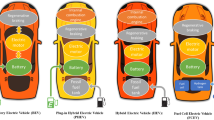Abstract
Thermoelectric generators (TEGs) are outstanding devices for automotive waste heat recovery. Their packaging, lack of moving parts, and direct heat to electrical conversion are the main benefits. Usually, TEGs are modeled with a constant hot-source temperature. However, energy in exhaust gases is limited, thus leading to a temperature decrease as heat is recovered. Therefore thermoelectric properties change along the TEG, affecting performance. A thermoelectric generator composed of Mg2Si/Zn4Sb3 for high temperatures followed by Bi2Te3 for low temperatures has been modeled using engineering equation solver (EES) software. The model uses the finite-difference method with a strip-fins convective heat transfer coefficient. It has been validated on a commercial module with well-known properties. The thermoelectric connection and the number of thermoelements have been addressed as well as the optimum proportion of high-temperature material for a given thermoelectric heat exchanger. TEG output power has been estimated for a typical commercial vehicle at 90°C coolant temperature.
Similar content being viewed by others
Abbreviations
- B :
-
Thermoelectric generator width, m
- b 1 :
-
Height of gas channel plate, m
- b 2 :
-
Height of water channel plate, m
- c p :
-
Specific heat, J/kg/K
- C th :
-
Thermal conductance, W/K
- dx :
-
Elementary length defined in Fig. 3b, m
- dy :
-
Elementary width defined in Fig. 3b, m
- h :
-
Gas heat transfer coefficient, W/m2/K
- I :
-
Current, A
- i :
-
Point index
- L :
-
Thermoelectric generator length, m
- l :
-
Thermoelement height, m
- \( \dot{m} \) :
-
Mass flow rate, kg/s
- n plate :
-
Number of plates within the heat exchanger
- n x :
-
Number of thermoelement couples in the generator
- n y :
-
Number of ranges in the generator
- P elec :
-
Power recovered as described in Eq. 7, W
- P elec,series :
-
Calculated recovered power with all thermoelements connected in series and an adapted load connected, W
- Q :
-
Heat transferred, W
- R elec,TE :
-
Electrical resistance of a thermoelement couple, Ω
- R th,cont :
-
Thermal contact resistance, m2 K/W
- S h :
-
Hot-side heat transfer surface, m2
- T :
-
Temperature, K
- U :
-
Overall heat transfer coefficient, W/m2K
- ZT :
-
Nondimensional thermoelectric figure of merit
- α pn :
-
Thermoelement couple Seebeck coefficient, V/K
- λ :
-
Thermoelement thermal conductivity, W/m/K
- η 0,h :
-
Overall fin efficiency
- ρ :
-
Electrical resistivity, Ω m
- cf:
-
Relating to cold fluid
- cont:
-
Relating to thermal contact
- hf,sup:
-
Relating to hot fluid gas
- max:
-
Maximum
- n :
-
Relating to n-type leg
- p :
-
Relating to p-type leg
References
J. Vazquez, M.A. Sanz-Bobi, R. Palacios, and A. Arenas, Proceedings of the 7th European Workshops on Thermoelectrics, paper 17 # (Pamplona, 2002).
K.M. Saqr, M.K. Mansour, and M.N. Musa, Int. J. Automot. Technol. 9, 155 (2008).
J.C. Bass, N.B. Elsner, and F.A. Leavitt, Proceedings of the 13th International Conference on Thermoelectrics, AIP (Kansas City, 1994).
K. Matsubara, Proceedings of the 21st International Conference on Thermoelectrics, IEEE (2002), p. 418.
J. Lagrandeur, 2009 Hydrogen Program and Vehicle Technologies Program Annual Merit Review (2009).
H. Shock, 2009 Hydrogen Program and Vehicle Technologies Program Annual Merit Review (2009).
T.J. Hendricks and J.A. Lustbader, Proceedings of the 21st International Conference on Thermoelectrics, IEEE (2002), p. 381.
D.T. Crane, D. Kossakovski, and L.E. Bell, J. Electron. Mater. 38, 1382 (2009).
T.J. Hendricks and M. Subramanian, Office of Vehicle Technologies 2009 Annual Merit Review (2009).
H. Peter, J. de Bock, and V. Novak, Proceedings of the Itherm Conference, IEEE (2008), p. 1276.
H. Peter, J. de Bock, and V. Novak. Proceedings of the 2nd Energy Nanotechnology International Conference, ASME (2007), pp. 1–7.
Hi-Z Technology, Inc. HZ-20 thermoelectric module [on line]. Available at http://www.hi-z.com/hz20.php (2008).
M. Lazard, G. Fraisse, C. Goupil, and H. Scherrer, Proceedings of the 6th European Conference on Thermoelectrics (2008), pp. 2–15.
D.T. Crane (PhD Dissertation, University of Maryland, 2003).
K.D. Smith (Master Dissertation, Rochester Institute of Technology, 2009).
W.M. Kays and A.L. London, Compact Heat Exchangers, 3rd ed. (New York: McGraw-Hill, 1984).
Aztech software, Melcor, v2B (1996).
C.M. Jaworski (Master Dissertation, Ohio State University, 2007).
M. Mori, T. Yamagami, N. Oda, M. Hattori, M. Sorazawa, and T. Haraguchi, SAE, 2009-01-170 (2009).
Acknowledgement
The authors would like to thank B. Lombard for reviewing and his support.
Author information
Authors and Affiliations
Corresponding author
Rights and permissions
About this article
Cite this article
Espinosa, N., Lazard, M., Aixala, L. et al. Modeling a Thermoelectric Generator Applied to Diesel Automotive Heat Recovery. J. Electron. Mater. 39, 1446–1455 (2010). https://doi.org/10.1007/s11664-010-1305-2
Received:
Accepted:
Published:
Issue Date:
DOI: https://doi.org/10.1007/s11664-010-1305-2




